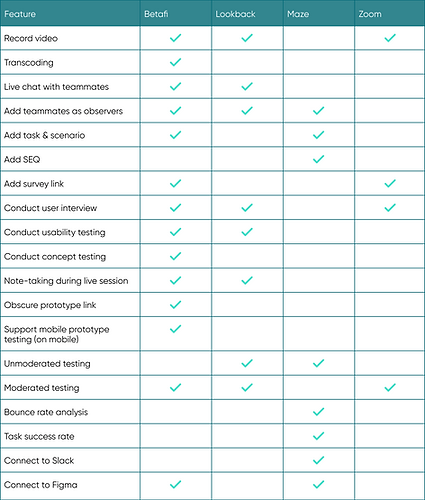
Betafi
Redesign with added features
Overview
Project summary
This is a 3-week client project with Betafi which is a start-up that aims to be the one-stop platform for early stage product research: from user interviews to concept tests and usability testing. For this project, my team and I were tasked to redesign the Betafi desktop experience and design the desktop-to-mobile transition for test participants.
My Role
I played the role of UX researcher and UI Designer in a group with 4 other team members.
Deliverables
-
Heuristics evaluation report
-
User research and persona
-
Customer journey map
-
Design system/guide
-
User flows
-
Sketches and wireframs
-
Interactive prototypes
-
Usability testing report
Discovery
Heuristic assessment of current site
We made use of Jakob Nielsen's 10 usability heuristics to measure the usability of the website by identifying usability problems, and reviewing their compliance. We then prioritised these issues based on severity and ease of fix ratings.

Putting the site to the test


Through the usability test of the live site, we uncovered a few major issues faced by the participants and provided design recommendations to tackle those issues.

Checking out the competition
We performed competitive and comparative analysis with Lookback and Maze as competitors, and Zoom as a comparative. We identified the pluses of Lookback and Maze to select features/characteristics we would like to adapt for Betafi. We also came up with a feature inventory across the platforms to assess available and desirable features to include in Betafi.
We found that Betafi already boasts many features that are not yet available on other platforms but was slightly lacking in the results analysis and synthesis portion.
Lookback

Maze

Feature inventory

Hearing from the users themselves
We spoke to 11 participants, who have experience in remote user research, to understand their habits, preferences, and pain points when carrying out remote user research. We wanted to find out the tools they used, their considerations when selecting those tools, their experience with auto-transcription tools, as well as, their preferred device type when carrying out desktop/mobile prototype usability tests and why.

Define
Identifying our target user group
Based on our interviews, we identified 1 key user persona to align the stakeholders and team on improving user experience with our tool.

Looking at the big picture
We mapped out Stella's journey when carrying out remote user research to understand her emotions at each step of the way and identified areas with possible improvements.
We decided to focus on addressing the issues faced by users when using the video call tool, and the transcription and results page used for research synthesis.

Develop
Figuring out the flow
We started the ideation process by mapping out the original Betafi user flow, from project & session creation to the live session itself. We marked out the steps/areas where users faced the most difficulties, and focused our design efforts there.
Zooming in on what's important
We identified what was most important by placing all the features on a User Need - Business Goals matrix. The green highlighted features were what we found to bring most value to both users, and business.

Turning ideas into designs
With our research and goals in mind, we did a brainstorming session and each sketched out our ideas before pitching them to the team. We agreed that we had to provide users with a guided project and session setup experience, with a clean comprehensive live session layout. Once the sketches were done, we translated them into wireframes to have a better idea of how the screens would be laid out.


Putting our designs to the test
With our sketches and wireframes in hand, we started setting up a design guide before moving into the creation of high-fidelity designs and interactive prototypes. A total of 2 rounds of usability tests were done with one round of iterations in between.


Deliver
Making the final changes
You can interact with the final prototypes below.
Checking our results
In each of the 3 usability tests, we made us of Single Ease Questions (SEQ), as well as System Usability Scale (SUS) to assess the design and flows.
*SEQ is a 7-point rating scale to assess how difficult users find a task. It is administered immediately after a user attempts a task in a usability test.
*SUS is a 10-question questionnaire that is used to evaluate the usability of products and services. It is administered immediately after a user completes all tasks within a usability test.
When comparing the results between the existing site, and our final design, the results pointed towards the final design being an improvement both in terms of ease of use, as well as usability.


Next steps
Develop additional personas
Carry out user interviews with people in other UX roles to gain insight of their experience during the user research journey. One of the biggest trade-offs we had to make in this project was exploring only 1 user persona. Additional personas (e.g. UX Design leads, Product managers etc) would have helped us increase the breadth of our design.
Further explore mobile solution
Users still expressed high reluctance in downloading mobile apps, especially for a one-time test.
Key takeaways
Design guides are super important
Completing the Design Guide before starting on prototyping was a key decision that made the design process move along very quickly. While it took some time to decide on details, making those decisions early on in the project made it easy to maintain consistency throughout the entire redesigned site. Having the design guide available for us to check back on also ensured we are always on the same page during the process.
Have regular check-ins with stakeholders
Getting to communicate design decisions directly with the Chief Technology Officer (CTO, Ethan) allowed us to ensure our designs were technologically possible. Being able to have the direct communication with the Chief Executive Officer (CEO, Arjun) also allowed us to refine our ideas and designs to the desired depth and scope, capturing more details.
